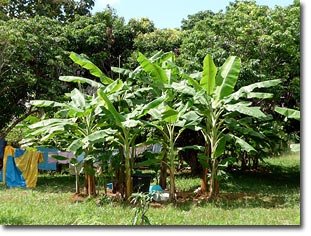




 2
2












Deston Lee wrote:
3) Each stalk will only produce 1 cluster of bananas. A corm will shoot out 2-4 stalks each year; they are thinned to one stalk in commercial operations.

















Big Island, Hawaii, 2,000 ft elevation, 200+ inches yearly rainfall.
Ua Mau Ke Ea O Ka Aina I Ka Pono




Kaiwiki wrote:
I'm on the big island of Hawaii, subtropic with ample (100"+) rainfall.
Bananas here can produce many bunches from one corm. I wouldn't recommend planting many vareities in one patch. I generally would say 15 ft spacing between patches. I start patches as 3-10 individual "keiki" (Hawaiian for child). If the keiki doesn't have a big root mass I cut off all the leaves and psuedostem about 3ft from the top of the corm. Expect a well fell banana circle with an interplant to turn into a solid clump of bananas. Some plants (taro, tumeric) grow even in the middle of an established patch, but bananas are for the most part greedy and don't lend themselves to understory. Vines (squash, legumes) climb well in bananas if planted a outside theirn root zone, but the root zone expands each year. I wouldn't reccomend bamboo and bananas being planted any closer than 10ft, and much more for big bamboo. Mollisons banana circles are too dense for this area unless you're using it as a pit toilet. Papayas get choked out before they can produce. I've had best luck with n-fixing plants And comfrey, lemongrasss etc to build soil as the bananas grow into the circle
manage your bananas well and they will produce. Cut away and replant all but 2-3 of the shoots that emerge from the mother corm - it will produce bigger, twister bunches. But then double this number next year, leaving 4-6 shoots in a second year pAtch. After a few years the patch will self regulate and produce fewer, stronger shoots. But, even old bananas patches like to be slashed to a few main psuedostems every few years
Tl;dr plant bananas densely, don't expect an understory, and feed them as much as possible. Bananas can be eaten ripe, cooked, dried, feedto poultry. The wastes (stalk, leaves, and peels) are relished by livestock. IMHO it's a waste of time and energy to crop bananas as anything but very dense, well fed patches.
 1
1




Big Island, Hawaii, 2,000 ft elevation, 200+ inches yearly rainfall.
Ua Mau Ke Ea O Ka Aina I Ka Pono
 1
1





Big Island, Hawaii, 2,000 ft elevation, 200+ inches yearly rainfall.
Ua Mau Ke Ea O Ka Aina I Ka Pono








Big Island, Hawaii, 2,000 ft elevation, 200+ inches yearly rainfall.
Ua Mau Ke Ea O Ka Aina I Ka Pono




Kaiwiki Clay wrote:Some varieties (the red varieties in particular i think) are highly resistant and can produce for years after becoming infected.
Still able to dream.


|
Liar, liar, pants on fire! refreshing plug:
Freaky Cheap Heat - 2 hour movie - HD streaming
https://permies.com/wiki/238453/Freaky-Cheap-Heat-hour-movie
|






